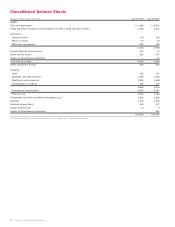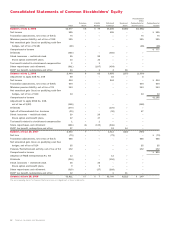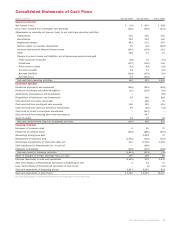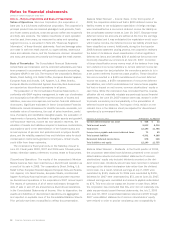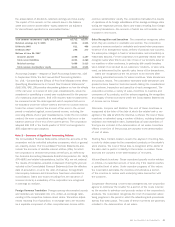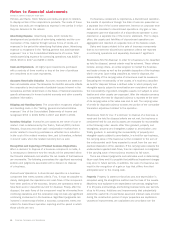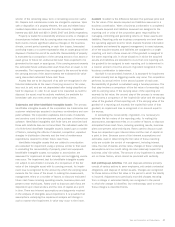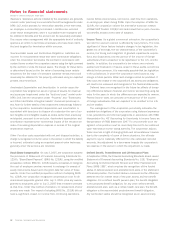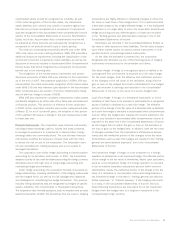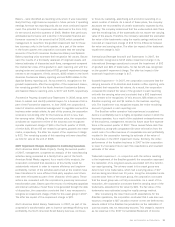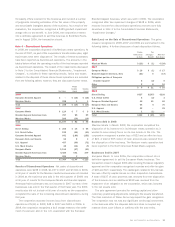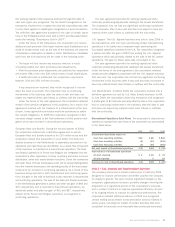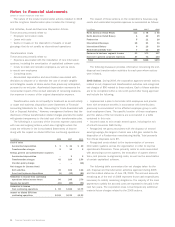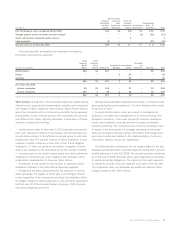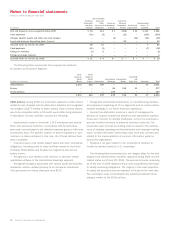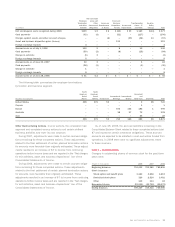Sara Lee 2008 Annual Report Download - page 52
Download and view the complete annual report
Please find page 52 of the 2008 Sara Lee annual report below. You can navigate through the pages in the report by either clicking on the pages listed below, or by using the keyword search tool below to find specific information within the annual report.
Notes to financial statements
Dollars in millions except per share data
Mark-to-Market Hedge
A derivative that is not declared as a hedge
in one of the categories above is accounted for under mark-to-market
accounting and referred to as a mark-to-market hedge. Changes in
the fair value of the derivative declared as a mark-to-market hedge
are recognized in the Consolidated Statements of Income to act
as an economic hedge against changes in the values of another
item or transaction. Forward exchange contracts are recorded as
mark-to-market hedges when the hedged item is a recorded asset
or liability that is revalued in each accounting period, in accordance
with SFAS No. 52, “Foreign Currency Translation.” For derivatives
designated as mark-to-market hedges, changes in their fair value are
reported in earnings in either the “Cost of sales” or “Selling, general
and administrative expenses” lines of the Consolidated Statements
of Income where the underlying transaction that is being hedged
is recorded.
Cash Flow Presentation
The settlement of derivative contracts
related to the purchase of inventory, commodities or other hedged
items that utilize hedge accounting are reported in the Consolidated
Statements of Cash Flows as an operating cash flow, while those
derivatives that utilize the mark-to-market hedge accounting model
are reported in investing activities. Fixed to floating rate swaps are
reported as a component of interest expense and therefore are
reported in cash flow from operating activities similar to how cash
interest payments are reported. The portion of the gain or loss on
a cross currency fixed to fixed swap that offsets the change in the
value of interest expense is recognized in cash flow from operations,
while the gain or loss on the swap that is offsetting the change
in value of the debt is classified as a financing activity in the
Consolidated Statement of Cash Flows.
Self-Insurance Reserves The corporation purchases third-party
insurance for workers’ compensation, automobile and product and
general liability claims that exceed a certain level. The corporation
is responsible for the payment of claims under these insured limits.
The undiscounted obligation associated with these claims is accrued
based on estimates obtained from consulting actuaries. Historical
loss development factors are utilized to project the future development
of incurred losses, and these amounts are adjusted based upon
actual claim experience and settlements. Accrued reserves, excluding
any amounts covered by insurance, were $202 and $187 as of
June 28, 2008 and June 30, 2007, respectively.
Business Acquisitions All business acquisitions have been accounted
for under the purchase method. Cash, the fair value of other assets
distributed, securities issued unconditionally and amounts of con-
sideration that are determinable at the date of acquisition are included
in determining the cost of an acquired business. Consideration that
is issued or issuable at the expiration of a contingency period, or
that is held in escrow pending the outcome of a contingency, is not
recorded as a liability or shown as an outstanding security unless
the outcome of the contingency is determinable.
Substantially all consideration associated with business acquisi-
tions involves the payment of cash. These amounts are disclosed
in the Consolidated Statements of Cash Flows.
Note 3 – Impairment Charges
The corporation has recognized impairment charges related to its
operations in 2008, 2007 and 2006 and the significant impairments
are recorded in “Impairment charges” in the Consolidated Statements
of Income. The impact of these charges, is summarized in the
following tables:
Pretax
Impairment After Tax
Charge Tax Benefit Charge
2008
Continuing operations
North American Retail Meats $÷(20) $«÷«8 $÷(12)
Foodservice (431) 16 (415)
International Bakery (400) – (400)
Total impairments 2008 $(851) $««24 $(827)
2007
Continuing operations
North American Retail Meats $÷(34) $««12 $÷(22)
North American Retail Bakery (16) 6 (10)
International Beverage (118) 9 (109)
Household and Body Care (4) – (4)
Total impairments 2007 $(172) $««27 $(145)
2006
Continuing operations
North American Retail Bakery $(179) $÷68 $(111)
International Bakery (14) 5 (9)
Continuing operations subtotal (193) 73 (120)
Discontinued operations
European Branded Apparel (179) 47 (132)
U.S. Retail Coffee (44) 5 (39)
U.K. Apparel (34) – (34)
U.S. Meat Snacks (12) 4 (8)
European Meats (125) – (125)
Discontinued operations subtotal (394) 56 (338)
Total impairments 2006 $(587) $129 $(458)
The following is a discussion of each impairment charge.
2008 Impairment Charges Recognized in Continuing Operations
North American Retail Meats Property and Trademarks
During
the fourth quarter of 2008, management determined that a North
American retail meats facility will be disposed due to its high cost
structure and reduced demand for the products produced at the
facility. Based on estimates of cash flows to be generated through
the date of disposition, the corporation concluded that it was nec-
essary to recognize an impairment charge of $20, of which $7 and
$13 are related to property and trademarks, respectively. The after
tax impact of this impairment charge is $12.
Foodservice and International Bakery Goodwill
The corporation
tests goodwill and intangible assets not subject to amortization for
impairments in the second quarter of each fiscal year and whenever
a significant event occurs or circumstances change that would more
likely than not reduce the fair value of these intangible assets. In
the second quarter of fiscal 2008, this review was performed and,
although the test did not indicate any reporting units may be impaired,
two reporting units – North American Foodservice Bakery and Spanish
50 Sara Lee Corporation and Subsidiaries


